Beyond the Usual: Exploring Tuscany Hidden Treasure: Southern Maremma & Monte Argentario
Where the Wild Heart of Tuscany Meets the Sea
There is a corner of Tuscany where the land still breathes in rhythm with nature, where the scent of Mediterranean scrub drifts from hillside to shoreline, and the silence is broken only by birdsong or the distant echo of the sea. Welcome to Southern Maremma, a rugged, unspoiled territory where authenticity reigns, and every trail, cliff, and cove whispers stories from millennia past
At the core of this landscape lies the Maremma Regional Park, a 9,000-hectare sanctuary stretching from Principina a Mare to Talamone. This is not simply a protected area—it is a living canvas of pine forests, wild pastures, sandy dunes, and shadowy marshlands. Here, longhorn cattle graze freely, deer slip through the underbrush, and birds from across Europe find safe haven in the lagoons. What was once the “bitter Maremma,” a mosquito-ridden swamp feared for centuries, is now one of the most enchanting natural paradises in Tuscany.
A few steps away lies the Lagoon of Orbetello, a shimmering expanse of shallow water embraced by twin sandbars, Feniglia and Giannella,and overlooked by the charming, almond-shaped town of Orbetello. This pristine aquatic landscape, now a WWF oasis, offers a rare mix of biodiversity, serenity, and cultural depth. Flamingos wade gracefully in still waters, while eels—once a staple of Etruscan cuisine—continue to define the region’s gastronomic soul.
Just beyond the lagoon, the land thrusts itself dramatically into the sea, forming the Monte Argentario promontory, a once-island, now tethered to the mainland by nature and human ingenuity. Its rugged cliffs and hidden coves create a dreamlike coastline where divers, sailors, and beach-lovers find their haven. The old fishing ports of Porto Ercole and Porto Santo Stefano, with their pastel-hued houses and working harbors, exude timeless maritime charm. From here, traditions like the Palio Marinaro, a spirited rowing race held each August, celebrate a seafaring legacy passed down through generations.
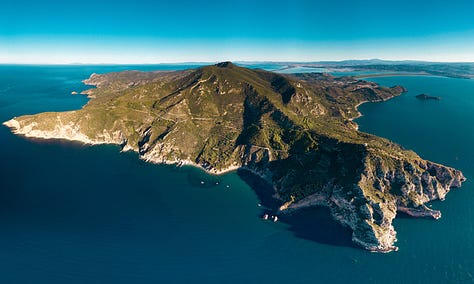
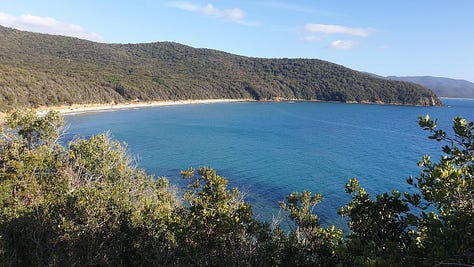
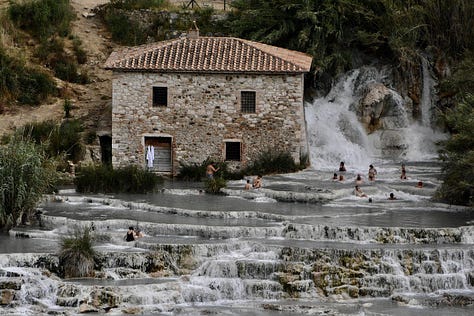
The allure of this area doesn't stop at the water’s edge. Just offshore, the Isola del Giglio beckons with crystalline waters, granite cliffs, and quaint villages that feel suspended in time. Further south, the crescent-shaped Isola di Giannutri hides Roman ruins and untouched coves accessible only by boat, perfect for those seeking rare solitude in nature.Inland, the Maremma continues to mesmerize. This is a land of Etruscan tombs and Roman ruins, of vineyards that yield the celebrated Morellino di Scansano, and of thermal springs like the Terme di Saturnia, where hot sulphurous waters pour from travertine cascades into warm natural pools. Villages like Montemerano, Manciano, and Magliano in Toscana offer quiet medieval beauty and local traditions untouched by time. And then there is Pitigliano, a stunning hilltop village carved from volcanic tufa, known as “Little Jerusalem” for its historic Jewish community. Seen from afar, it appears to float above the valley, a storybook citadel of stone and sky.
To journey through Southern Maremma is to witness a Tuscany few tourists ever truly know: wild, sensuous, ancient, and deeply alive. From the sparkling shallows of Orbetello’s lagoon to the rugged heights of Monte Argentario and the mystic pathways of Etruscan tombs, every step reveals a new layer of wonder.
Monte Argentario
Monte Argentario is a stunning promontory in southern Tuscany, surrounded by crystal-clear sea and connected to the mainland by the natural sandbars of Giannella and an artificial isthmus known as the Orbetello Dam. The region is part of the Maremma Grossetana and includes two main towns: Porto Santo Stefano and Porto Ercole. With its unique landscape, mild climate, and picturesque environment, Monte Argentario is an ideal destination for year-round holidays. Rich in history and natural beauty, the area is perfect for hiking and biking through lush Mediterranean scrub, offering breathtaking views.
Porto Santo Stefano
Located on the northern side of Monte Argentario, Porto Santo Stefano is a charming seaside town and ferry point to the Island of Giglio. The seafront, designed by Giorgetto Giugiaro, is perfect for a scenic walk. The most iconic landmark is the Spanish Fortress, a 17th-century defensive structure that today houses two permanent exhibitions: "Sunken Memories", featuring archaeological finds from the seabed, and "Shipwright Masters", dedicated to traditional boatbuilding.
Nature lovers will enjoy trekking paths that lead inland, surrounded by lush greenery. The nearby Convent of the Passionist Fathers, founded in 1737 by Saint Paul of the Cross, is another significant spiritual and architectural site.
Popular beaches include the sandy Giannella Beach, and more secluded spots like Cala del Gesso and Cala Grande, ideal for peaceful relaxation away from tourist crowds.
Porto Ercole
On the southern coast of Monte Argentario lies Porto Ercole, one of Italy’s most beautiful villages since 2004. The old town features narrow cobbled streets, quaint squares, and flower-decked balconies overlooking the harbor and bay. Historically, it is linked to the famed painter Caravaggio, who died here in 1610 under mysterious circumstances. A plaque near the Church of Sant’Erasmo marks this connection, and the supposed burial site is now part of the modern village.
The town is dominated by impressive Spanish fortresses from the 16th century: Forte Filippo, Forte Stella, and La Rocca, all of which offer magnificent sea views. For beachgoers, there are many choices: from Spiaggia Lunga and Spiaggia delle Viste to the family-friendly Acqua Dolce Beach and Cala Galera.
Nature enthusiasts should explore the Feniglia Nature Reserve, home to deer and a wide variety of flora and fauna, or visit the nearby Corsini Botanical Garden, which boasts over 1300 plant species including orchids and succulents.
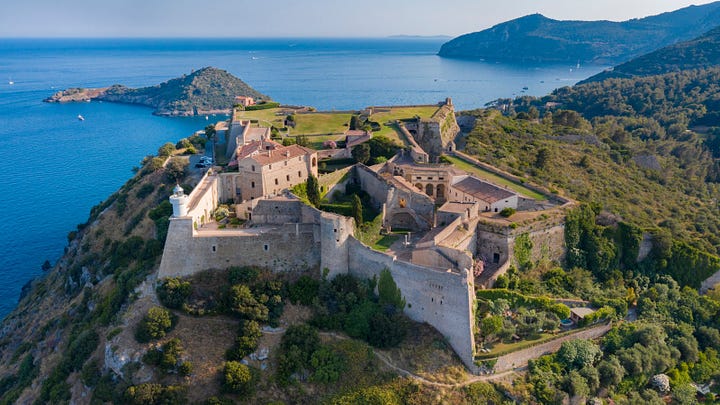
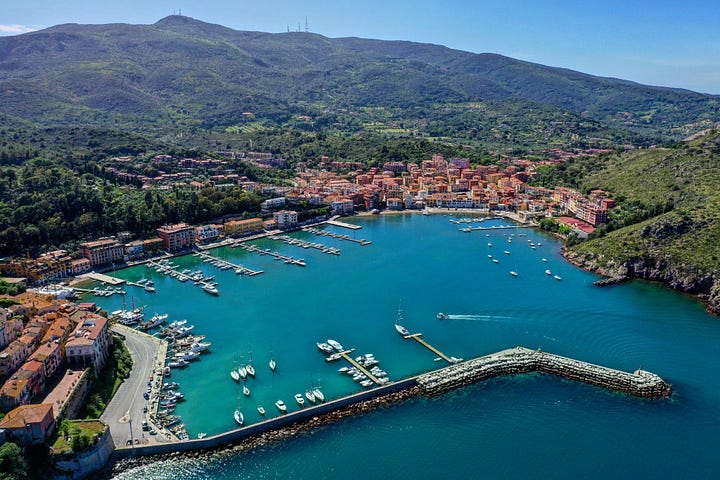
Orbetello & Ansedonia
Orbetello is a unique Tuscan town perched on a narrow almond-shaped isthmus reaching into its own lagoon. With origins dating back to the Etruscan period,traces of which still survive in its ancient fortified walls, it later became a strategic port under the Spanish State of the Presidi.
In the small village of Saline, two notable Spanish-era structures remain: the Forte delle Saline and the historic Casale Spagnolo, a former manor built to serve the salt pans.
The Orbetello Lagoon is now a vital WWF-protected wetland, roughly 1,500 hectares in area and under two meters deep, fostering rich biodiversity, including flamingos, herons, ospreys, egrets, eels, mullet, and more . This salina-tombolo system is bordered on the seaward side by two 6 km long sandy “tomboli”:
Feniglia: stretching between Ansedonia hill and Monte Argentario
Giannella: extending from Monte Argentario to the mouth of the Albegna River.
Connected to Monte Argentario since 1841 via the dramatic Leopoldine Dam, Orbetello is your gateway to Porto Santo Stefano and Porto Ercole. Its historic center is enclosed by formidable ramparts: the original Etruscan walls, later reinforced by the Spanish defensive gates, highlighted by a grand triple arch topped with royal arms. Just beyond the lagoon, Talamone is a scenic and historic fishing village on a rocky promontory, featuring a medieval fortress with panoramic views of the Tyrrhenian and Giglio Island. This village traces its roots to the Neolithic era and was later inhabited by Etruscans and Romans
Nearby Ansedonia is also home to major archaeological treasures:
The Archaeological Park of Cosa, preserving the remains of a Roman port colony (3rd century BC).
The enigmatic Tagliata Etrusca, a canal hewn into living rock.
The “Spacco della Regina”, a deep cavern with mythic connotations—said to be treading the line between nature and legend.
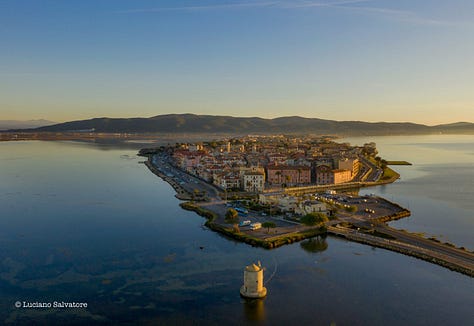
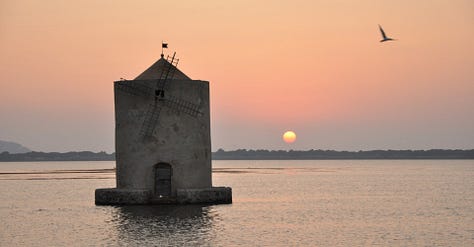
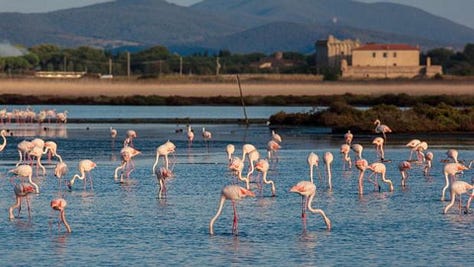
Castiglione della Pescaia & Surroundings
Nestled between the sea and the hills, Castiglione della Pescaia is a medieval fishing village known for its golden beaches and extensive pine forests stretching to Marina di Grosseto. The old town is enclosed by ancient walls and crowned by a majestic castle. Key landmarks include the Church of San Giovanni Battista, Santa Maria del Giglio, and Palazzo Centurioni, which hosts cultural events.
The harbor area is lively, especially in the evenings when fishing boats return and sell their fresh catch at the fish market. The promenade is perfect for relaxing walks, with restaurants and bars offering sea-view dining. Local markets, like the one near Ponte Giorgini on Saturdays, showcase traditional Tuscan life.
Nearby attractions include the Etruscan site of Vetulonia, the medieval hamlet of Tirli, and Buriano, offering panoramic views of the Maremma landscape.
A few kilometers away is Punta Ala, a luxurious coastal resort with a modern marina and long sandy beaches surrounded by thick pine forests. Another popular spot is Le Rocchette, with its scenic castle perched on a rocky cliff.
Nature lovers can visit the Diaccia Botrona Nature Reserve, one of Italy’s most important wetlands, home to the Casa Rossa Ximenes, a museum showcasing the area’s ecological importance. Isola Clodia, within the reserve, contains remains of a Roman villa and a medieval Benedictine abbey.
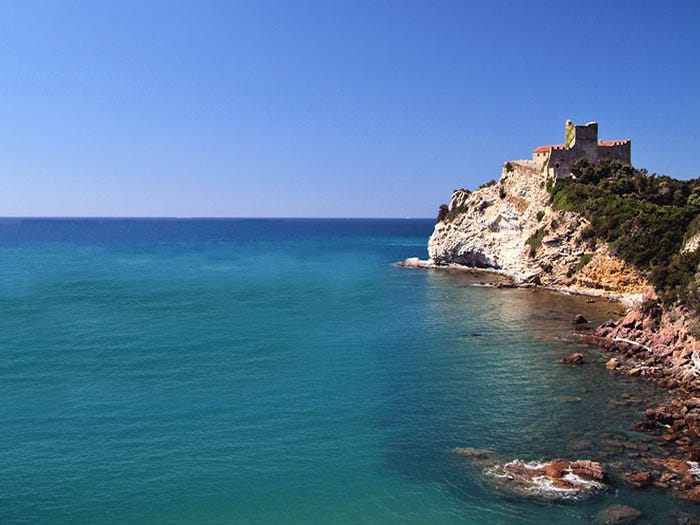
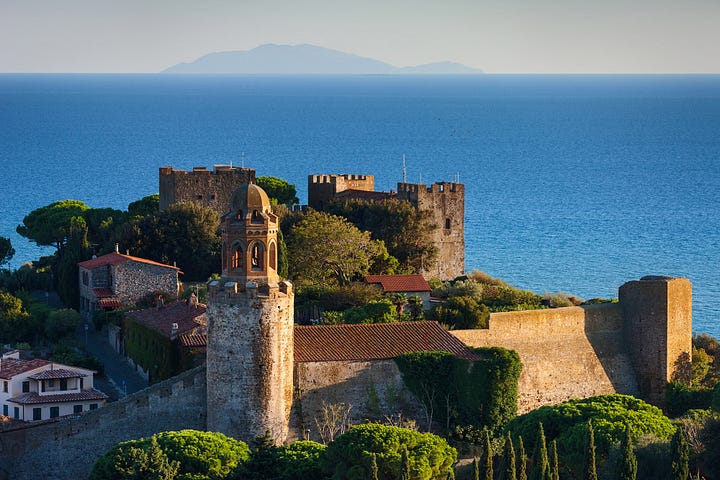
coff.ee/christinemytuscanyroots









So beautiful! I love Tuscany. I can’t wait to go back and explore more places. Thanks for sharing